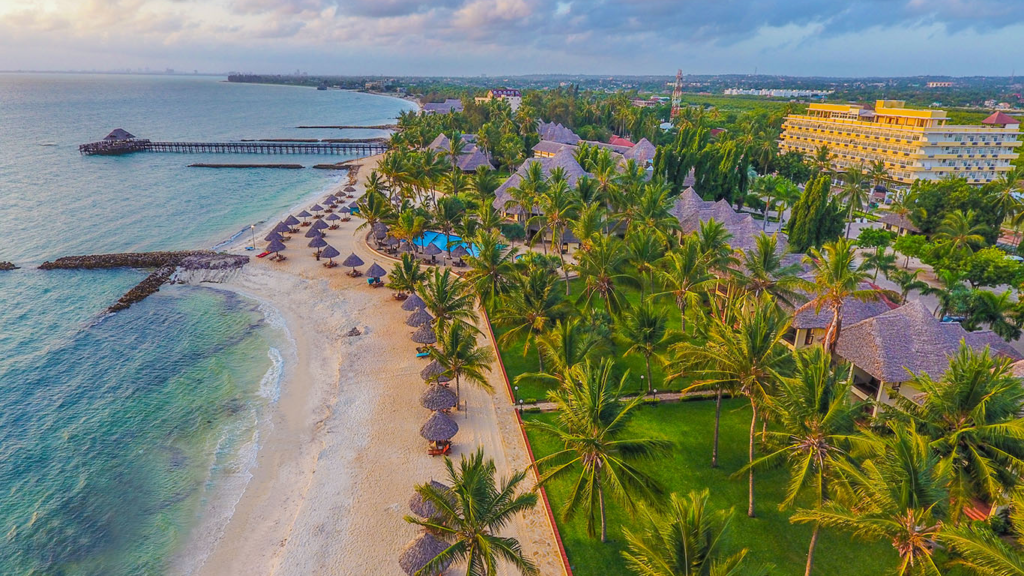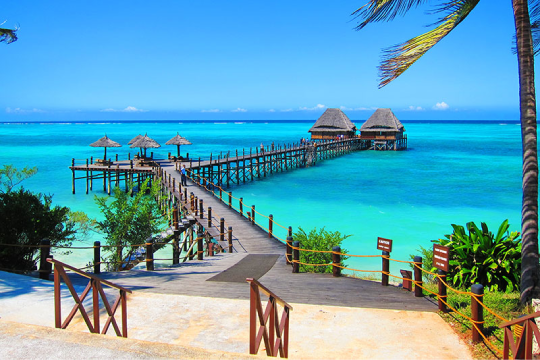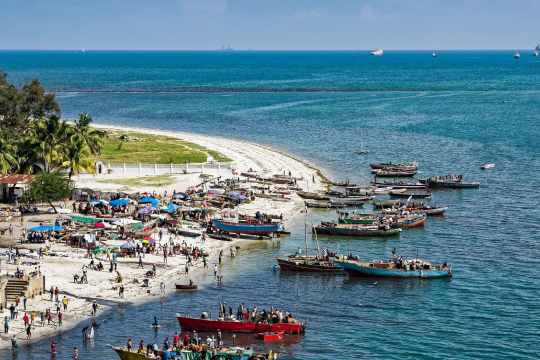Tanzania
- Home
- Tanzania

Explore Tanzania
Embark on an unforgettable safari vacation in Kenya, the birthplace of safari travel. Experience the thrill of Big 5 game viewing, marvel at breathtaking natural beauty, and immerse yourself in vibrant cultural encounters. Witness the awe-inspiring Great Migration in the legendary Masai Mara, enjoy the iconic views of Mount Kilimanjaro in Amboseli, and encounter leopards in Samburu. Explore authentic Masai villages and savor the diverse flavors of Africa, India, and Europe within the vibrant Swahili culture. Kenya’s highlight is the annual spectacle of the Great Migration, where immense herds of wildlife follow the rhythm of nature. Enhance your adventure by combining Kenya with Tanzania and Rwanda, including gorilla trekking. With a range of safari and beach combination tours, you can indulge in Kenya’s scenic beauty and wildlife before relaxing on tropical islands. Whether it’s a family safari, romantic getaway, adventurous honeymoon, or milestone celebration, Kenya offers something for every traveler, with luxurious accommodations and exceptional service to elevate your experience.
Tanzania’s safari areas generally experience warm days and cool evenings throughout the year. However, the temperatures on Mount Kilimanjaro and Mount Meru can drop below freezing, while the coastal regions along the Indian Ocean and lakeside areas tend to be hot and humid.
The country has two distinct rainy seasons: the “long rains” from April to May and the “short rains” from November to December. During the long rains, there are heavy tropical downpours in the afternoons, leading to the closure of many safari camps. On the other hand, the short rains season brings occasional brief showers, but safari camps remain open, and game viewing opportunities are still good.
The ideal time for a Tanzania safari depends on your preferred destination and what you wish to see. For first-time safari goers, the dry season is usually recommended as wildlife is more easily trackable and visible. It’s important to understand the difference between the safari high season and low season when planning your visit to Tanzania, especially if it’s your first time exploring the country’s remarkable wildlife.
Where To Go

As a part of The Serengeti, synonymous with safari adventures, stands as the ultimate destination in Tanzania for witnessing breathtaking game viewing moments. Renowned as the prime location for the awe-inspiring Wildebeest Migration, which takes place from January to September, the Serengeti offers an unmatched spectacle. With its expansive size, convenient accessibility, exceptional lodges and camps, and a constant presence of wildlife throughout the year, it is rightfully hailed as one of Africa’s premier safari destinations. Unsurprisingly, it is a must-visit stop on the finest Tanzania safari tours. renowned Masai Mara-Serengeti ecosystem and renowned for the iconic wildebeest migration, Kenya’s flagship conservation area may not be the largest, but it provides the most awe-inspiring game viewing and diverse safari experiences. The Masai Mara is the ultimate destination for thrilling hot air balloon flights, exhilarating game drives, immersive cultural interactions, and guided nature walks in private conservancies. It’s no surprise that this extraordinary destination is hailed as one of the world’s greatest travel experiences.

Imagine gathering approximately 30,000 animals and confining them within the confines of an extinct volcano crater. Now, envision adding wetlands, forests, and sprawling grasslands to this extraordinary environment, complemented by cliff-top accommodations that seem to belong in another world. This is the remarkable Ngorongoro Crater, an exceptional destination for safari enthusiasts in Tanzania. Within its boundaries, visitors can experience unparalleled game viewing amidst a setting that defies belief. Renowned for its ability to deliver effortless and dependable sightings of the Big 5 in East Africa, the Ngorongoro Crater offers what is arguably the pinnacle of safari experiences in Tanzania.

Tarangire, located near Lake Manyara and the Ngorongoro Crater, offers much more than a typical day visit. During the dry season from June to October, it boasts high concentrations of animals, especially elephants, along the Tarangire River. With over 500 bird species, it is a paradise for birdwatchers, while the presence of diverse predators adds to its appeal. Tarangire’s stunning wilderness features riverine forests, expansive swamps, and iconic baobab trees, making it a rewarding destination for wildlife enthusiasts and bird lovers alike, showcasing the richness of Tanzania’s natural beauty.

As a part of The Serengeti, synonymous with safari adventures, stands as the ultimate destination in Tanzania for witnessing breathtaking game viewing moments. Renowned as the prime location for the awe-inspiring Wildebeest Migration, which takes place from January to September, the Serengeti offers an unmatched spectacle. With its expansive size, convenient accessibility, exceptional lodges and camps, and a constant presence of wildlife throughout the year, it is rightfully hailed as one of Africa’s premier safari destinations. Unsurprisingly, it is a must-visit stop on the finest Tanzania safari tours. renowned Masai Mara-Serengeti ecosystem and renowned for the iconic wildebeest migration, Kenya’s flagship conservation area may not be the largest, but it provides the most awe-inspiring game viewing and diverse safari experiences. The Masai Mara is the ultimate destination for thrilling hot air balloon flights, exhilarating game drives, immersive cultural interactions, and guided nature walks in private conservancies. It’s no surprise that this extraordinary destination is hailed as one of the world’s greatest travel experiences.

Complete your East Africa safari adventure with an enchanting getaway to Zanzibar, the Spice Island of Tanzania. Whether you’re traveling with family or on a honeymoon, Zanzibar offers an idyllic escape with its stunning beaches, vibrant coral reefs, captivating sunset dhow trips, and the opportunity to explore fragrant backstreet markets. Tanzania’s other Indian Ocean islands, including Pemba, Mafia, and Chole, are equally impressive beach destinations that promise superb diving experiences, exclusive boutique accommodations, and indulgent pampering to fulfill your every desire.

TaraRuaha National Park stands out among safari destinations with its untamed and untethered character. This hidden gem, Tanzania’s largest national park, remains relatively undiscovered, with only a handful of safari camps despite its vast size. Here, you will encounter a wilderness untouched by hordes of tourists, but teeming with a diverse array of wildlife. From majestic buffalo, giraffes, and kudus to rare and elusive species like sable antelopes, roan antelopes, lions, cheetahs, and leopards, Ruaha offers an abundance of captivating animal sightings. Moreover, it proudly hosts Tanzania’s largest elephant population and serves as a stronghold for the preservation of the endangered African wild dogs. Ruaha’s allure lies in its ability to provide an authentic and immersive safari experience in a truly wild and awe-inspiring environment.ngire, located near Lake Manyara and the Ngorongoro Crater, offers much more than a typical day visit. During the dry season from June to October, it boasts high concentrations of animals, especially elephants, along the Tarangire River. With over 500 bird species, it is a paradise for birdwatchers, while the presence of diverse predators adds to its appeal. Tarangire’s stunning wilderness features riverine forests, expansive swamps, and iconic baobab trees, making it a rewarding destination for wildlife enthusiasts and bird lovers alike, showcasing the richness of Tanzania’s natural beauty.

Selous, Africa’s largest game reserve spanning an area larger than Switzerland, holds a captivating allure. Its heartbeat is the mighty Rufiji River, weaving a complex tapestry of channels, swamps, and lakes that give birth to one of East Africa’s most extraordinary ecosystems. Within this remarkable wilderness, a thriving community of buffalo, hippos, crocodiles, and lions coexist harmoniously. Moreover, Selous stands as a vital sanctuary for the endangered wild dog, solidifying its significance in conservation efforts. Embarking on a boat safari, guided walk, or fly-camping adventure in this breathtaking wilderness is a must-do, immersing you in the untamed beauty of Selous and creating memories to last a lifetime.

Nestled within the mountainous walls of the Great Rift Valley, Lake Tanganyika, the world’s longest freshwater lake, showcases a mesmerizing ecosystem. Its remarkable biodiversity is amplified by the presence of Mahale Mountains and Gombe Stream National Parks, making it one of the planet’s most biologically rich habitats. Despite their remote locations, these two exceptional destinations, Mahale Mountains and Gombe Stream, offer unparalleled and distinctive safari experiences in Tanzania. Immerse yourself in the lush tropical rainforest surroundings and witness captivating wildlife encounters, including remarkable chimpanzee trekking, making the effort to reach these hidden gems well worthwhile.

Whether you’re awed by its towering presence or inspired to conquer its icy summit, the legendary Mount Kilimanjaro is an experience that will leave an indelible mark on your soul. Standing tall at 5,895 meters (19,340 feet), it reigns as Africa’s highest mountain and the tallest freestanding mountain in the world. Surprisingly, the snow-capped peaks are more accessible than you might imagine. During the dry seasons from July to October or January to March, reaching the summit does not require technical climbing skills. However, organizing and executing a successful trek to the top does necessitate careful logistical planning. Reach out to us to embark on a Kilimanjaro expedition and turn your dreams into reality.

As the undisputed safari capital of Tanzania, Arusha plays a crucial role in the itineraries of travelers visiting the Serengeti, Ngorongoro Crater, and Lake Manyara. Due to logistical considerations, an overnight layover in or near the city is often necessary. Nestled in the shadow of Mount Meru, Arusha boasts its own international airport, Kilimanjaro International Airport, as well as the smaller Arusha Airport for charter flights to final destinations. Exploring Arusha offers ample opportunities to purchase souvenirs, immerse yourself in cultural activities, and visit local points of interest.

While most visitors to Tanzania’s Dar es Salaam are en route to Zanzibar or the captivating Indian Ocean coast, this vibrant city also serves as a gateway to Tanzania’s hidden gems, including the lesser-known reserves like Selous. Offering convenient access, Dar es Salaam allows travelers to embark on unforgettable adventures in these pristine wilderness areas. Moreover, the city provides a range of high-quality accommodations for those in need of an overnight stay before continuing their journey.
Tanzania Travel Advice
At Intisar Travel Agency, our passion lies in delivering exceptional safari experiences and providing unbiased advice to our clients. Our dedicated team of Africa Safari Experts is based in Africa, allowing them to have firsthand knowledge and extensive experience of the destinations they recommend. Continuously traveling and exploring, they regularly inspect new lodges, experiences, and activities to ensure they meet the high expectations of our clients.We understand the value of up-to-date and relevant travel information, especially when it comes directly from someone who has personally experienced it. That’s why we strive to provide our clients with the most current and insightful details, allowing them to make informed decisions and create unforgettable travel experiences.
Plan your timing: Ensure your itinerary aligns with your desired experiences, such as witnessing the Wildebeest Migration or enjoying ideal beach weather in Zanzibar.
Book early for high season: Tanzania’s popular safari destinations and camps in Wildebeest Migration hotspots fill up quickly, often requiring reservations up to a year in advance.
Choose activities wisely: While game drives are common, note that specific activities like night drives, bush walks, and hot-air balloon safaris are limited to certain areas or camps.
Expect high-season crowds: Heavyweight national parks like Serengeti, Ngorongoro Crater, Lake Manyara, and Tarangire draw many visitors from June to October. For a more secluded experience, consider visiting during the low or Green Season (November to March).
Go private for exclusivity: Tanzania’s private reserves offer exceptional accommodations, comparable game viewing, and occasional additional safari activities, providing an exclusive and intimate experience.
Tipping is customary for lodge staff and drivers/guides on a Tanzania safari, but it’s advisable to check if a service charge has already been included in your bill. Tipping should be considered separate from the price quoted by your operator, and the amount varies based on factors like group size, safari luxury level, and the quality of service provided. In major Tanzanian cities, it is customary to leave a 10% tip in restaurants and bars when a service charge is not already included.
Tipping is customary for lodge staff and drivers/guides on a Tanzania safari, but it’s advisable to check if a service charge has already been included in your bill. Tipping should be considered separate from the price quoted by your operator, and the amount varies based on factors like group size, safari luxury level, and the quality of service provided. In major Tanzanian cities, it is customary to leave a 10% tip in restaurants and bars when a service charge is not already included.
Tanzania has two main international airports. Kilimanjaro International Airport serves popular safari destinations like the Serengeti, Ngorongoro Crater, Tarangire, and Lake Manyara, while Dar-es-Salaam International Airport is the gateway to the Indian Ocean coast, Zanzibar, Selous Game Reserve, and Ruaha National Park. For regional flights, Arusha Airport is the access point for northern Tanzania’s safari airstrips. Closed 4×4 vehicles with big windows and pop-up roofs are used for road transfers and game drives, providing optimal viewing and photography opportunities.
Tanzania’s history spans millions of years, with evidence of human settlement found at sites like Olduvai Gorge. From Iron Age migrations to European colonization, including the dark era of the East African slave trade, Tanzania eventually gained independence in the 1960s. Today, the country’s economy is driven by agriculture, while tourism plays a vital role as the largest foreign exchange earner. With its diverse ethnic groups and a culture rooted in courtesy and respect, Tanzania offers a harmonious national identity. English and Swahili are the official languages, reflecting unity in this vibrant and culturally rich nation.
It is recommended to use US Dollars as the preferred currency in Tanzania. Cash is advised over credit cards and traveler’s checks, as the latter may incur transaction fees. ATMs are available in major towns and cities but not within national parks and game reserves.
Please note that Tanzanian Shillings are the official currency, but US Dollars are widely accepted. It’s important to mention that US Dollar bills printed before 2006 are not accepted in Tanzania.
For a Tanzania safari, it’s recommended to pack light, casual clothing in practical, neutral colors. Additionally, carrying a warm jacket for evening game drives is advisable year-round. For detailed guidance on what to pack, please refer to our Africa Safari Guide.
When visiting Zanzibar, it’s important for women to dress modestly in main towns as a sign of respect for Muslim cultural beliefs. Opting for T-shirts that cover the shoulders, long skirts, and capri pants is generally more appropriate than tank tops and shorts. On the beaches and in resorts, beachwear and bathing costumes are acceptable attire.
Tanzania is a country with strong religious beliefs, predominantly Christianity and Islam. Islam is particularly prominent along the coast and in Zanzibar. It’s important for visitors to be aware of the conservative nature of these destinations, especially Stone Town, and to dress and behave respectfully.
Tanzanians are known for their friendliness and harmonious nature. It is considered polite to ask for permission before taking photographs of people.
A visa is required for almost all visitors to Tanzania. It is important to contact the relevant authorities well in advance (preferably several months ahead) to determine the entry requirements and arrange the necessary permits and visas. We highly recommend obtaining visas online from the Tanzania Immigration Department before arriving in the country, particularly for those entering through Kilimanjaro International Airport. Please note that e-visas can take approximately 2 to 3 weeks to be issued. Additionally, visitors must have a passport that remains valid for at least six months from the initial date of travel.
Tanzania’s diverse landscape encompasses the vast central plateau, nestled between the arms of the Great Rift Valley, bordered by Africa’s great lakes, towering mountains including Kilimanjaro, and the Indian Ocean. With expansive grasslands, open woodlands, and savannah dominating the majority of the country, remote mountain ranges harbor pockets of lush rainforests. Renowned for its abundant wildlife, Tanzania is a premier destination for game viewing, boasting 20% of Africa’s large mammals. Over a quarter of the country is dedicated to conservation, hosting some of the world’s largest animal reserves. While the northern region attracts most visitors with its famous and accessible reserves, the less-explored southern and central parts offer vast, untouched savannah and rainforest reserves for truly off-the-beaten-track safaris.
